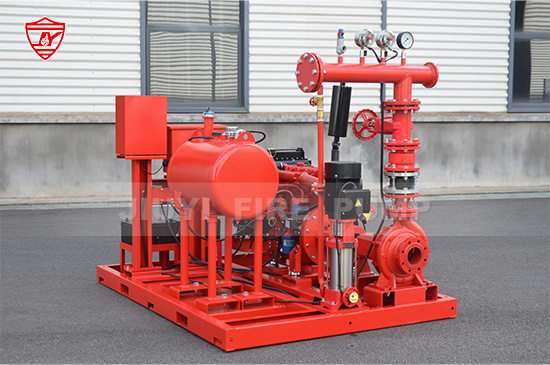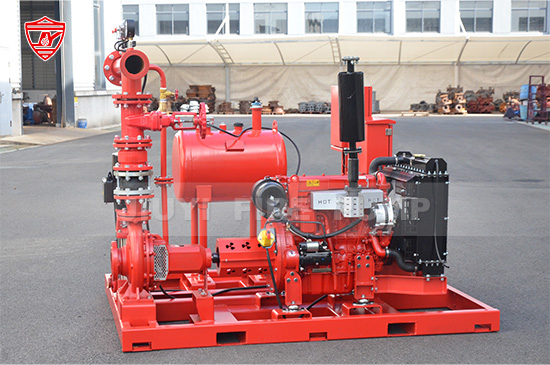Fire pumps are the heart of a fire protection system, designed to ensure that water pressure and flow are sufficient in case of fire emergencies. However, their reliability depends on regular testing and maintenance. A fire pump that sits idle for months may fail to start or perform poorly when needed most. This is why weekly fire pump testing is essential — it verifies operational readiness and ensures compliance with NFPA 25, the standard for inspection, testing, and maintenance of water-based fire protection systems.
In this article, we’ll go through everything you need to know about conducting a fire pump weekly test safely and effectively — whether it’s an electric motor-driven fire pump or a diesel engine-driven fire pump.

Weekly testing helps identify mechanical, electrical, and performance issues early before they become critical failures. It also maintains the reliability of automatic starting mechanisms, which can seize or malfunction without regular use.
Here are the main benefits of conducting weekly tests:
Ensures readiness: Confirms the pump will start automatically when a fire occurs.
Detects issues early: Identifies leaks, vibrations, or unusual sounds before they cause breakdowns.
Maintains compliance: Meets NFPA 25 requirements and satisfies insurance or authority inspections.
Extends lifespan: Regular operation keeps bearings, seals, and valves lubricated and functional.
According to NFPA 25, weekly testing is required for diesel engine-driven fire pumps, while electric motor-driven fire pumps can be tested weekly or monthly depending on system design and local regulations. However, many facility managers perform both types weekly to ensure consistency and reliability.
The test must include:
Automatic start (initiated by pressure drop)
Observation of pump performance (pressure, flow, sound, vibration)
Recording suction and discharge pressures
Checking for leaks and abnormal noise
Ensuring correct system restoration after testing
Before performing the weekly fire pump test, follow these preparatory steps to ensure safety and accuracy:
Notify relevant personnel: Inform the fire department, monitoring service, and building occupants that a test will be conducted to avoid false alarms.
Check system valves: Make sure all valves are in the correct position. The suction valve and discharge valve should be fully open.
Verify the power supply: Ensure the electric supply or diesel fuel system is in good condition.
Inspect the pump room: Confirm the pump room is clean, free from obstruction, and adequately ventilated.
Review last test records: Compare performance trends with previous test results to identify gradual changes.
The most important part of the weekly test is confirming that the fire pump can start automatically. Simulate a drop in system pressure by slightly opening the test header valve or pressure relief valve.
Electric fire pump: Observe that the motor starts immediately once the pressure switch detects a drop.
Diesel fire pump: Verify that the engine cranks and starts automatically.
Make note of the start time, smoothness of operation, and any unusual delay.
Once the pump is running, observe the suction and discharge pressure gauges. Record the readings to compare them with previous tests. Stable readings indicate proper pump and valve performance.
Abnormalities to look for:
Sudden pressure drop → possible suction obstruction or leak
Excessive fluctuation → possible air entrainment or valve issue
Listen closely for any unusual noise, grinding, or rattling. These may indicate mechanical issues such as bearing wear or coupling misalignment.
Also, check for vibration — excessive vibration may cause long-term damage to the pump assembly and piping.
While the pump is running, walk around the system to check for water leaks from packing glands, fittings, or casing joints. Minor dripping from mechanical seals may be normal, but excessive leakage requires maintenance.
For diesel engine-driven fire pumps, additional checks are necessary:
Confirm cooling water flow is steady and unobstructed.
Check engine oil level and coolant temperature.
Ensure battery voltage is within the normal range (typically 24 volts for most systems).
Also verify that the fuel tank is adequately filled and free of contamination.
NFPA 25 recommends operating the pump for at least 10 minutes during the weekly test for diesel pumps and no less than 10 minutes for electric pumps if required by the system.
During this time, monitor all readings to ensure consistent performance.
After completing the test, close the test header valve or restore system pressure to normal. Observe that the pump stops automatically after the pressure returns to the setpoint.
If the pump fails to stop automatically, check the pressure sensing lines or controller settings.
Accurate record-keeping is crucial. A proper log should include:
Date and time of test
Pump type (electric/diesel)
Suction pressure (psi or bar)
Discharge pressure (psi or bar)
Start and stop times
Any abnormal observations (noise, vibration, leaks)
Corrective actions taken
Keeping consistent data helps detect gradual deterioration over time, allowing preventive maintenance before failure occurs.
Failure to start automatically: Often caused by faulty pressure switches or disconnected sensing lines.
Abnormal vibration: May indicate misalignment or worn bearings.
Low discharge pressure: Could be due to partially closed valves, suction blockage, or impeller wear.
Diesel engine cranking failure: Often related to weak batteries or low fuel quality.
Controller malfunction: Requires inspection by a qualified technician.
Never run the fire pump with the discharge valve closed for extended periods.
Keep hands and clothing away from moving parts while the pump is operating.
Always follow the manufacturer’s operating manual.
Make sure the test is supervised by trained personnel familiar with fire pump systems.
After testing, ensure the system is restored to full automatic operation.
NFPA 25 requires that all test results be documented and retained for review by fire inspectors, insurers, or local authorities. A Fire Pump Test Log should be maintained at the pump room, including at least 12 months of records.
Digital log systems are also increasingly common — many modern fire pump controllers automatically record data and generate performance trends, helping maintenance teams identify issues faster.

Performing a weekly fire pump test is a vital part of maintaining a reliable fire protection system. It ensures that your pump — whether electric or diesel-driven — will operate instantly and effectively in the event of a fire.
By following a structured, step-by-step testing routine and keeping accurate records, facility managers can prevent costly failures, meet NFPA 25 compliance, and most importantly, protect lives and property.
As a manufacturer of fire pumps, we always recommend users conduct weekly testing with diligence and precision. A well-maintained fire pump isn’t just a compliance requirement — it’s your first line of defense when every second counts.